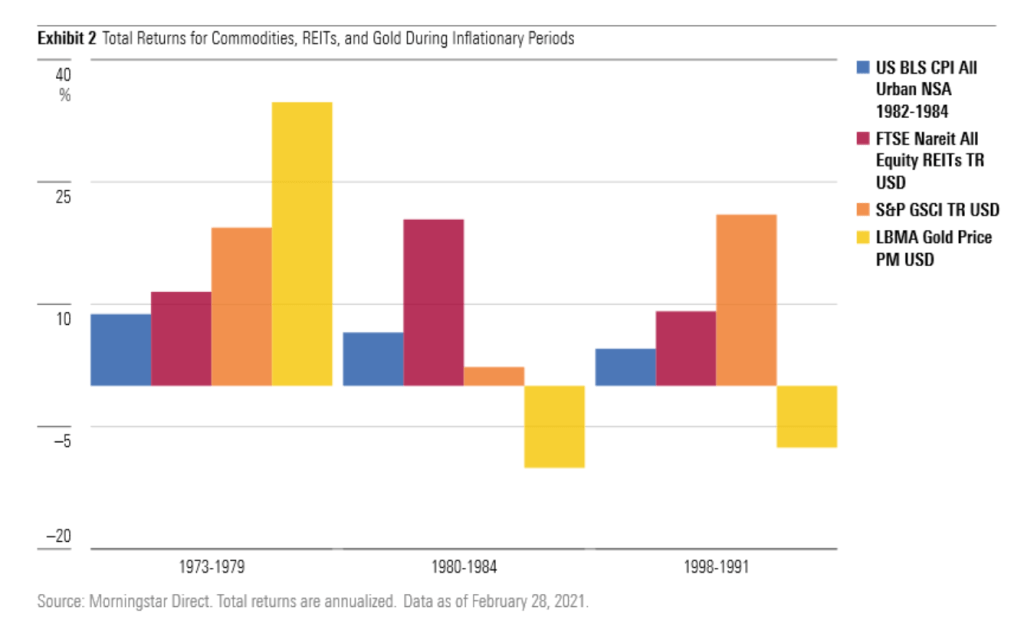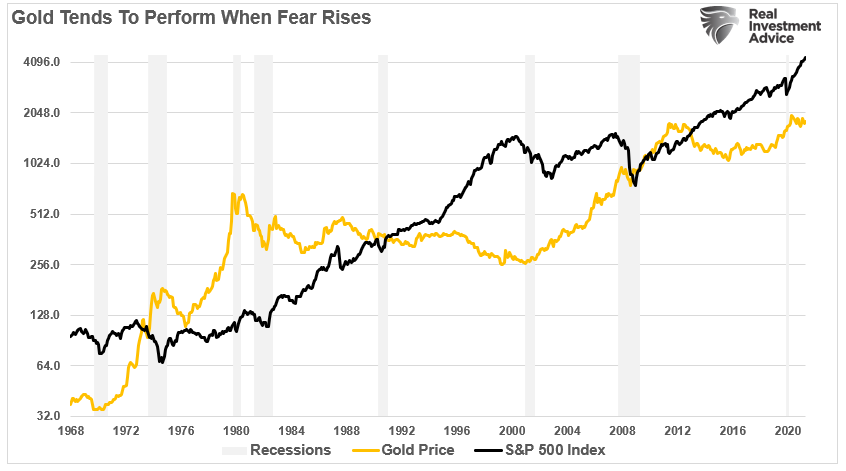 By Dale Roberts, cutthecrapinvesting
By Dale Roberts, cutthecrapinvesting
Special to the Financial Independence Hub
It is probably the greatest (and potentially dangerous) misconception in the investing landscape, that stocks protect you from inflation. That’s simply not true. While stocks have a long term history of besting inflation, they can fail in many periods, short and extended. Stock markets do not always work as an inflation hedge. And Vanguard suggests that their effectiveness will wane as the types of stocks that can work against inflation no longer have strong representation in the broad market stock indices. We’ll show you how to protect against inflation on the Sunday Reads.
Let’s cut to the chase. It’s something I’ve known for quite some time and I’m more than happy to see Vanguard beat the drum. If you want to protect your portfolio from inflation or stagflation (its evil stag cousin) own commodities.
When you own commodities or a commodities index fund or ETF, you own the raw materials that make the products, foods and energy needed to sustain life and society as we know it.

Stocks don’t work
Let’s get this out of the way first, shall we, from this Vanguard post, the potency of commodities as an inflation hedge …

And that’s during a period when we’ve mostly had muted inflation. Stocks don’t like unexpected inflation, like the kind we’re having in 2021. That is, inflation above recent trends and expected trends.
If we go back to the stagflation period of the 1970’s and into the early 1980’s it’s a complete mess for stock investors. Have a look at MoneyChimp and be sure to hit that inflation button. This shows a negative real (inflation adjusted) return from 1968 through 1982, for US stocks. In real dollar terms, $1.00 became 94 cents.

Global stocks did not perform much better. And surprisingly neither did the Canadian stock market that was more commodities and energy-concentrated for the period.
Here’s global stocks for the period showing no return premium vs inflation. The chart is courtesy of ReSolve Asset Management.

And in this post on the Permanent Portfolio, you’ll see that even the traditional stock and bond balanced portfolio failed for an extended period during stagflation. There are other periods of ‘don’t work’ for the balanced portfolio (and for different reasons) within that chart.
Commodities hedge is strong and consistent
While stocks are not a consistent hedge for inflation, commodities have been, historically. And once again, this is during a period of mostly muted inflation, save for a few periods of unexpected inflation. Luckily for investors, that inflation has been transitory in the last few decades.

From that Vanguard post …
Over the last three decades, commodities have had a statistically significant and largely consistent positive inflation beta, or predicted reaction to a unit of inflation. The research, led by Sue Wang, Ph.D., an assistant portfolio manager in Vanguard Quantitative Equity Group, found that over the last decade, commodities’ inflation beta has fluctuated largely between 7 and 9. This suggests that a 1% rise in unexpected inflation would produce a 7% to 9% rise in commodities.
Here’s a great chart that shows gold, commodities and REITs as inflation hedges in periods of meaningful inflation. The orange bar is the commodities index.

While gold was the most explosive during the bulk of the period of stagflation, we see that a commodities basket is more reliable. Admittedly, gold can fall down as an inflation hedge in certain periods. That said, there are other reasons for holding gold as a hedge against declining real bond yields and as a form of disaster insurance and a long term hedge against ongoing currency debasement.

In the above chart we see gold working in all of the stock market failures for the period shown. Again, most notably during stagflation.
I like to also hold some gold and gold stocks on the side in addition to commodities baskets. Readers will also know that I am also investing in bitcoin – that new gold or digital gold.
Real return bonds are weak
While we’ll often talk about using part of the fixed income component to address inflation, it is a weakling compared to commodities. In the U.S. they’ll refer to them as TIPS (Treasury Inflation-Protected Securities). That’s perhaps not a bad add to the portfolio, but you might also consider using the real inflation fighters, because you can use less of them to get the job done.
From Vanguard …
Inflation-protected bonds are by their nature intended to hedge against inflation. But with a far lower beta to unexpected inflation (around 1), they would require a significantly higher portfolio allocation to achieve the same hedging effect as commodities.2
For inflation, do you want to order up a number 1, or a number 8? I’m going x8, thank you very much. With bitcoin maybe it’s x100 over time, ha. Thanks to modern monetary theory and all.
Real inflation is here, is it transitory?
We are in a period of unexpected inflation. It is more pronounced in the U.S., but it is also certainly well above trend and expectations in Canada and around the globe. In this week’s Making Sense of the Markets for MoneySense I looked at the chip shortage and the supply chain issues. That is a fascinating post I hope you’ll find. The world runs on chips. Perhaps chips/semiconductors are also a modern commodity?
Maybe chips are the new oil.
Those in the ‘inflation is transitory’ camp will suggest the pockets of shortages and supply chain problems will work their way through, and will dissipate.
Who knows? I certainly have no idea if inflation is here to stay, or how extreme things might get. Let’s admit we don’t know the future.

This Wolf Street post suggests that inflation in the middle of the price pipeline is 20%. Those increases in costs might eventually be passed along to the consumer – that ‘s you. Also wages are increasing, and that is a sticky component to inflation. It is difficult to go back and start cutting wages.
Transitory for longer?
Again, no one knows the future, but there are signs that inflation might be more in the camp of ‘transitory for longer’.
Whether you add a real inflation hedge to your portfolio is up to you. Just don’t fool yourself into thinking that stock markets are the ticket.
You might at least consider a 10% commodities hedge. Factor in your inflation-friendly stocks such as those Canadian energy stocks and other industrials, REITs and commodity-related holdings. That might add additional strength to your 10% commodities weight.
I like the Purpose Diversified Real Asset ETF as a one-stop shop. You can also look to Horizons suite of commodities ETFs.
There are many options in U.S. dollar ETFs.
Do your own research before you invest. Take this as information, not advice.
On My Own Advisor, Mark had also offered a fighting-inflation post.
More Sunday Reads
Also on MoneySense, from a few week’s back (I forgot to share) Jason Heath looks at how much should you withdraw from your RRIF?
And here’s a can’t-miss event as Jonathan Chevreau will offer a virtual money talk show designed to help retirees and near-retirees build their nest eggs and then draw income from them. (i.e. Accumulation and Decumulation).
On My Own Advisor Mark asks and answers why would anyone own bonds now? And also check out Mark’s Weekend Reads with portfolio drawdown options.
And I should have added this Banker on Wheels post to last weeks Sunday Reads – rethinking retirement (RIP). Look for that retirement video within the Banker post.
At Tawcan Bob offers the top Canadian Dividend ETFs and why he doesn’t own them. That’s a very good breakdown and rationale. Great read!
Thanks for reading, we’ll see you in the comment section. Are you hedging for inflation?
 Dale Roberts is the Chief Disruptor at cutthecrapinvesting.com. A former ad guy and investment advisor, Dale now helps Canadians say goodbye to paying some of the highest investment fees in the world. This blog originally appeared on Dale’s site on Sept. 12, 2021 and is republished on the Hub with his permission.
Dale Roberts is the Chief Disruptor at cutthecrapinvesting.com. A former ad guy and investment advisor, Dale now helps Canadians say goodbye to paying some of the highest investment fees in the world. This blog originally appeared on Dale’s site on Sept. 12, 2021 and is republished on the Hub with his permission.

